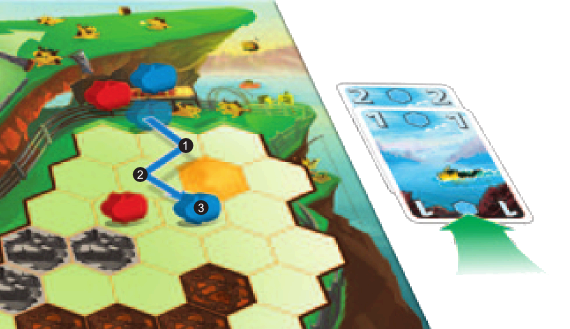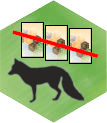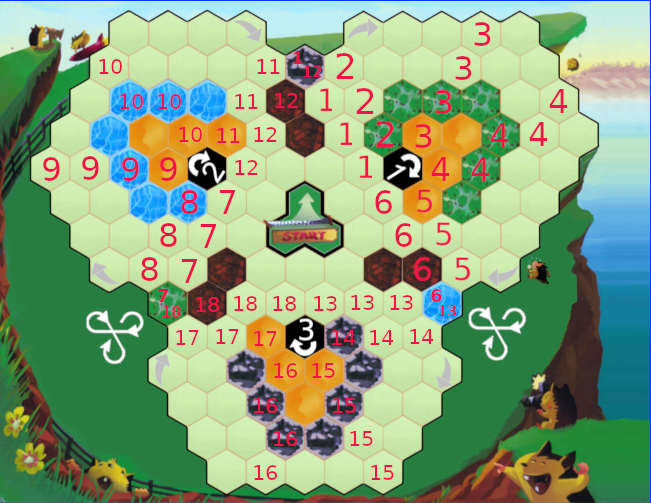|
|
Currently showing detailed version of the rules.
Currently showing summary version of the rules.
→ Show summary version
→ Show detailed version

Lemminge
GAME COMPONENTS

Terrain Cards
In order to make the cards readable also on small screens like on mobiles or tablets, the Yucata implementation uses different card representations. The following images show the same card on large, middle and small screen:
IDEA OF THE GAME
LEMMINGE – who jumps first? That is the motto of this little race to the big jump into cool water. On the way to the top, large and small obstacles may block your path, some of which are put there by other players. But look out: If you get in the way of other lemmings, you may find yourself getting pushed aside and overtaken.
GAME SETUP
Place the board in the middle of the table. Each player chooses a color
and takes the two matching lemmings. Place your lemmings in the fenced-in start area on the board.
Place one card with the value "2" of the five different terrains
(forest ,
water ,
mountain ,
swamp or
desert )
next to the board:
They start the five different terrain piles. The bonus tiles are placed next to the terrain piles. The remaining terrain cards are shuffled and starting hands are dealt. Depending on the number of players, each player receives the following number of cards:
- In a game of 2 players, the start player receives 5 cards, the other player 6 cards.
- In a game of 3 players, the start player receives 4 cards, the other players in turn one more than the player before, meaning 5 and 6 cards.
- In a game of 4 players, the start player receives 3 cards, following players 4, 5 and 6 cards respectively.
- In a game of 5 players, the start player receives 2 cards, following players 3, 4, 5 and 6 cards respectively.
The player who can jump furthest is start player.
The Yucata implementation determines the startplayer randomly.
PLAYING THE GAME
The game is played in a clockwise direction, beginning with the start player. On your turn you choose between two actions:
MOVING A LEMMING
Each card shows a value between 0 and 4 and belongs to one of the five terrain types
.
Choose one of the cards in your hand and compare its value to the top card on the matching terrain pile.
Note on the use of the term top card in this rule:
The top card, in the sense of a stack of overlapping cards from top to bottom (see blue cards in the picture below), actually means the card lying nearest to the bottom, i.e. the last card played.
In the Yucata implementation, the cards are not displayed overlapping but are all fully visible, one below the other.
There are two possibilities:
-
If the value on your card is lower or the same as the top card of the matching terrain pile, put your card on top of that terrain pile. Make sure that the values of all cards in the pile stay visible.
Then move one of your lemmings up to as many spaces as the sum of all cards in that terrain pile.
Example: Eric (blue) plays a value "1" water card. The topmost card on the water pile shows a "2", so Eric can place his card on top of that terrain pile. He can move his lemming three spaces this turn.

EVERYTHING YOU NEED TO KNOW ABOUT LEMMING MOVEMENT
The lemmings enter the playing area by crossing the green starting line and leave it by crossing the green finish line. The lemmings may be moved onto the light green meadow spaces
and onto spaces that match the terrain
/
/
/
/
card played. The terrain type only has to match when moving onto a space. For leaving a desert space, for example, you do not need a desert card. Only one lemming may sit on any space. It is not allowed to skip over a lemming, but you can push it along ahead of your own lemming (see Pushing lemmings).
You can only move one of your lemmings each turn. You can move a lemming fewer spaces than shown by the cards.
-
If the value on your card is higher than that of the topmost card on the respective terrain pile, that terrain pile is put on the discard pile and you start a new terrain pile with your card. In addition you receive a bonus tile of the same terrain type. You must place the bonus tile immediately onto any space on the board. In this manner you change the terrain type of this space and so make things easier for yourself or harder for your rivals!
Afterwards you may move one of your lemmings up to as many spaces as the value on your card.
Example: Sanya (red) plays a value 4 water card. The topmost card on the water pile has the value 1, therefore she must put the whole water pile on the discard pile and begin a new water pile with the value 4 card she just played. In addition, she receives a
water bonus tile which she places onto a helpful space for her lemmings. With her 4 movement points, she moves 4 onto the bonus tile she just placed.

EVERYTHING YOU NEED TO KNOW ABOUT BONUS TILES
You receive a bonus tile when you start a new terrain pile. You must place the tile immediately, before moving your lemming.
If the bonus tiles of a terrain type
/
/
/
/
have run out, you receive a light green meadow tile instead. If, in turn, the meadow tiles run out, you do not receive a bonus tile.
If a new bonus tile is put onto a space that already has a bonus tile, remove the existing bonus tile from the game - it is not returned to the supply.
A bonus tile may also be placed underneath a lemming.
PUSHING LEMMINGS

During his movement, your lemming may push other lemmings. Pushing a lemming only works if you have enough movement points to both move your lemming onto the occupied space and to move all lemmings in front of it one space forward.
A lemming pushes another lemming by moving onto the space the other
lemming occupies and then pushing this other lemming on one space in the
same direction. It is not allowed to push a lemming aside. If more than one lemming is standing in front of your lemming, all of them are pushed. When pushed, lemmings may be moved onto any terrain type, but they must never be pushed out of the playing area. It is allowed to push lemmings across the finish line. You may also push your own, second lemming.

Example: Eric (blue) plays a value 3 water card. The topmost card on the water pile is a 4. Therefore, he puts his card on top of the water pile and now has 7 movement points for this turn. He moves his lemming 3 spaces just behind Sanya’s red lemming. Then he pushes Sanya’s lemming in the same direction 1 space forward and moves his lemming on the now free space. This costs him 2 movement points. For the remaining 2 movement points he moves his lemming on in the direction of the finish line.

REFILLING YOUR HAND
Instead of playing a card and moving a lemming, you refill your hand. Before you draw cards, you may discard as many cards from your hand as you like. Then you refill your hand to 6 cards. After that your turn ends.
The Yucata.de implementation uses the additional rule that was used for the german board game team competition 2014 which entails showing all discarded cards to the other players. In practice this means that all cards in the discard pile are visible.
DRAW PILE EMPTY?
If the draw pile is exhausted, the discard pile is shuffled and becomes the new draw pile. If, at this moment, both "0" cards of a terrain type lie open on a terrain pile, all cards of this terrain pile except for one "0" card are also put on the discard pile. The remaining "0" card starts the new terrain pile of this type. Only then is the discard pile shuffled and then used as the new draw pile.
END OF THE GAME
The player who gets his two lemmings across the finish line first wins the game.
When playing with more than 2 players, the Yucata.de implementation uses the additional rules from the german board game team competition 2014.
Let n be the number of players (2 <= n <= 5):
- The game immediately ends when n-1 players have reached the finish with both their lemmings. For relative placements of the players, the time when the 2nd lemming of a player enters the finish is used (the earlier, the better). The only player whose 2nd lemming didn't reach the finish places last in the ranklist.
- The remaining hand cards of players which have already finished the game are put on the discard pile.

VARIANT WITH FOX TILES

Six additional fox bonus tiles are included with the following rules:
If the appropriate landscape bonus tile is still available, then this must be used. If it's not available, then you can use your choice of a meadow tile (if it is still available) or a fox tile (if it is still available). If neither is available, then you don't get a bonus tile.
The cost of moving onto a fox tile is one movement point (like a meadow tile). However, when you move onto it you must discard three cards. If you don't have 3 cards on your hand, you cannot move onto a fox tile. Lemmings which are pushed onto that terrain space also have to discard up to three cards (if they have them).
Notice: In contrast to actively moving onto a fox tile, a lemming may still be pushed onto a fox tile if that player has less than 3 cards on his/her hand.
Moving a Lemming
In order to push a Lemming, the pushing Lemming first needs to be moved next to the Lemming that shall be pushed. Pushing is only possible if the Lemming is next to the Lemming it wants to push. A Lemming can be pushed by clicking the field of the Lemming that shall be pushed.
If the Lemming shall move without pushing, then instead of doing single steps, the target field can also be directly clicked. Attention: On the "Circuits" race track it can happen that the target field cannot be reached this way with just one click.
This is the case if the Lemming may move very far and the target field can be reached in clock- as well as counterclockwise direction around a post. In this case it's best to first click on the field that is the farthest from the Lemming in the desired rounding direction and then on the finally wanted target field.
Showing the cards in the discard pile
Hovering over the discard pile will show all cards in it.
Showing the cards in the draw deck
Hovering over the card deck will show all cards of the game without the cards that are known not to be in the deck:
- cards in the discard pile
- own hand cards
- cards currently lying in the terrain piles
So the cards shown are the cards remaining in the card deck plus the unknown cards on the other players' hands.
Adjusting the layout of the game window
Per default the layout is adjusted automatically so that on a broad screen all window areas are visible (bonus tiles, terrain piles, game board, and hand cards) and on narrow screens the game board is displayed as large as possible, making it necesssary to scroll.
This automatism can be disabled via the options tab in the game window sidepanel. Then you can manually switch between the two modes.
Turn off vertical card images
Usually, the card images change as the width of the game window increases: 1. vertical with one big number, 2. horizontal with field symbol, 3. orginal graphic. However if you only want to see the vertical card display with only one large number (1.), you can set this in the game options.
Locate a logged bonus tile on the board
Hover over a bonus tile in the game log in order to highlight the field where it has been placed. This way you may find out who put which bonus tile where and when.
Disable Animations
If you want to make fast moves or your browser has display issues, then you can select to not show animations via the options menu.
Disable Lemming Traces
If you find the lemming traces on the board disturbing, you can disable them via the options menu. On the other hand, you can enable there, that all lemming traces are always displayed.
Start and finish on the race track "Circuits"
Here the Lemmings start in the board center, round the field with the "1", then the one with the "2" and then the one with the "3" to finally cross the finish line again in the board center. The white arrows on the board shall indicate this path.
Lemming progress in the "Circuits"
Before a lemming is allowed to enter the finish field, it must have been on certain fields in sequence (see image below). First it must have been on one of the fields marked with "1", then on one of those marked with "2" and so on.
If a lemming has already been on one of these fields (in the correct sequence), then it won't lose this progress anymore - even in the case in which it is pushed back by other lemmings.
Attention: It's no good to only have visited the fields 6, 12 and 18. It is necessary to have visited every group of numbered fields in ascending order!
Navigation Help
Directly after start the lemming is marked with a "1" on its back to indicate that it needs to go around the post 1 first. As soon as it has progressed this way to one of the fields marked with "6", it gets a "2" on its back, which means that it must go around the post 2 next. Accordingly it receives a "3" on one of the fields marked with "12". After it has been on one of the 18s fields, it may now move into the finish with a "F" (for "Finish") on its back.
If you hover your mouse over a lemming, then the location of the post is shown, which needs to be circuited next. Those players who want to know the lemming progress on a field bases, can set the option "Detailed Lemming Advancement" in the sidepanel.

| |